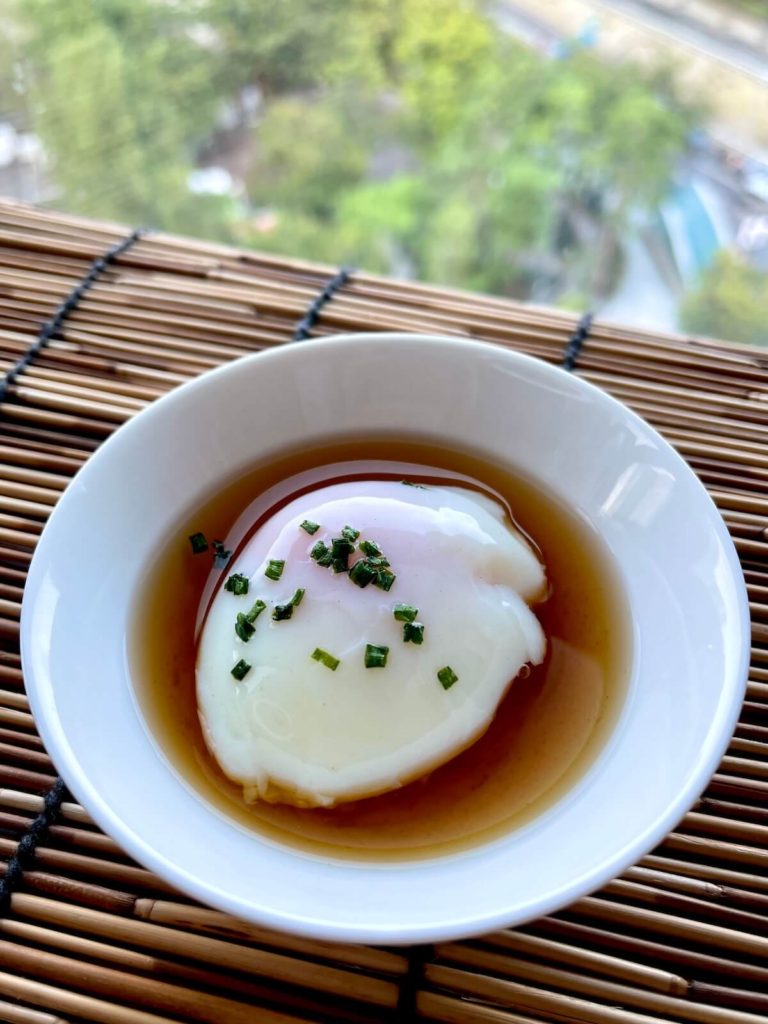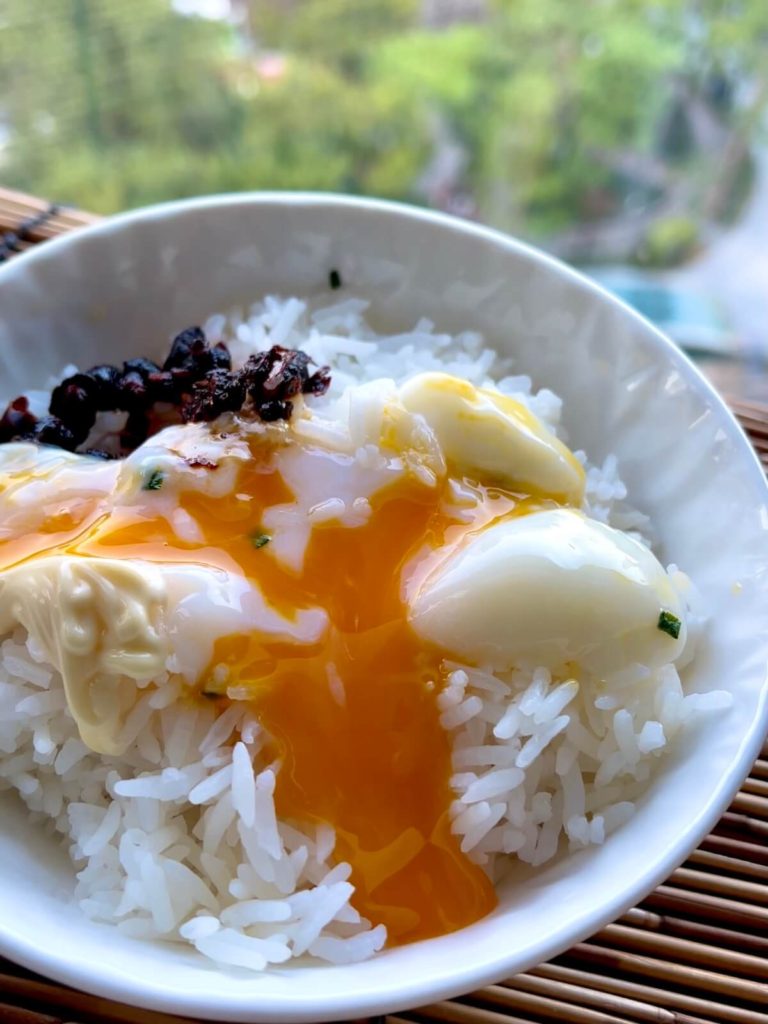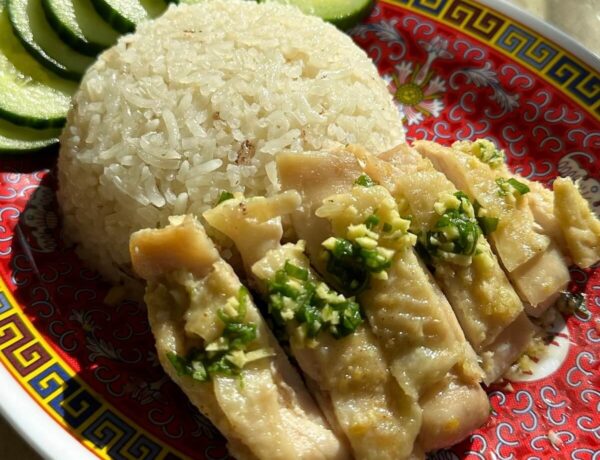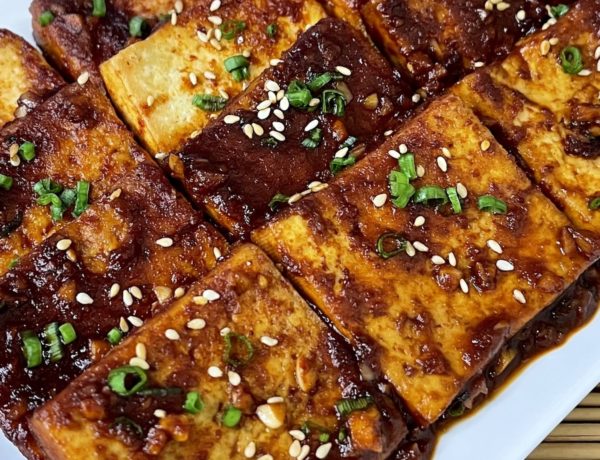These silky soft eggs with a warm, runny center are perfect for a simple, yet so satisfying meal.

What is onsen tamago?
Onsen tamago translates to “hot spring egg” in Japanese. Traditionally, eggs were slowly cooked in hot springs to produce silky smooth eggs with a custard-like yolk. The egg whites are very milky and soft, while the yolk is firm and creamy.
I love the taste and texture of onsen tamago, but if you prefer your eggs to be a bit more firm then simply add and extra minute or 2 to the cooking time.
How to enjoy onsen tamago
Do you like poached eggs? If so, then you will LOVE onsen tamago. I like to cook a batch and keep it in the fridge for easy meals throughout the week.
My absolute favorite way to eat onsen tamago is on top of a bowl of steamy white rice, a spoonful of hot chili oil and a dollop of kewpie mayo (Japanese mayo). It’s so simple but so delicious. Onsen tamago is also a great side dish – just pour a few spoonfuls of the sauce on top.

The sauce
The sauce recipe is very simple and requires just 4 ingredients:
- dashi – Japanese soup stock
- soy sauce
- mirin – Japanese rice wine
Bring all of the ingredients to a boil and then let it cool in the fridge. The sauce can be poured over the egg and also tastes great over rice.

Important tips:
Temperature is key when making onsen tamago, so measure the water for best results. First, bring 4 cups of water to a rolling boil and remove from heat. Pour in ⅔ cup lukewarm water, which is water that is only slightly warm. This brings the temperature down and is necessary to achieve the perfect consistency of silky smooth eggs.
Use cold eggs, straight from the refrigerator. Some recipes call for room temperature eggs, but this step is not necessary. Simply use large eggs from the fridge for this recipe.
Be careful when adjusting this recipe. Adding more than 4 eggs might extend the cooking time. Also, the water should be enough to completely submerge the eggs with about an inch left on the top.
Hot Spring Egg video tutorial
Need more egg ideas?
- gyeran mari (Korean egg roll)
- mayak eggs
- gyeran jjim (Korean steamed eggs)
- tamago sando (Japanese egg sandwhich)

Onsen Tamago (hot spring egg)
- Total Time: 25 minutes
- Yield: 4 eggs 1x
Description
These silky soft eggs with a warm, runny center are perfect for a simple, yet so satisfying meal.
Ingredients
- 4 cups water
- ⅔ cup lukewarm water (to pour in later)
- 2 tsp salt (optional)
- 2 tbsp white vinegar (optional)
- 4 large eggs, cold
Sauce:
- ¼ cup dashi (Japanese soup stock) *see note
- ½ tsp soy sauce
- 2 tsp mirin
Instructions
- Bring 4 cups of water to a boil in a medium sized pot (the water should be enough to fully cover the eggs with about an extra inch of water on top). Add the salt and vinegar to the pot which helps breakdown the egg shells.
- Remove the pot from heat and pour in the lukewarm water to cool it down. Gently drop in the eggs and cover. Let it sit for 18 minutes for silky soft eggs with a runny center, or add an extra minute or two if you want it cooked through more.
- In the meantime, prepare the sauce by adding the dashi, soy sauce and mirin to a saucepan. Taste test it and adjust the measurements as desired – mirin will make it sweeter and soy sauce will add saltiness. Bring it to a boil then turn off the heat and let it cool in the fridge.
- Once the eggs are done cooking, drain and place into a bowl of ice water. Let it sit for 10 minutes.
- After 10 minutes, crack the bottom side of the egg and peel away the pieces until the egg is able to easily fall out. Spoon over the sauce and enjoy! I like to eat hot spring eggs with a bowl of rice, kewpie mayo and hot chili sauce. It also makes the perfect ramen topping!
Notes
I buy dashi flakes from the Asian market for convenience. Simply add water and it’s done! Chicken broth can be substituted, but use dashi for best flavor.
- Prep Time: 5 minutes
- Cook Time: 20 minutes
- Cuisine: Japanese food
Keywords: onsen tamago, japanese egg, hot spring egg


